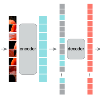Dialogue Enhancement (DE) enables the rebalancing of dialogue and background sounds to fit personal preferences and needs in the context of broadcast audio. When individual audio stems are unavailable from production, Dialogue Separation (DS) can be applied to the final audio mixture to obtain estimates of these stems. This work focuses on Preferred Loudness Differences (PLDs) between dialogue and background sounds. While previous studies determined the PLD through a listening test employing original stems from production, stems estimated by DS are used in the present study. In addition, a larger variety of signal classes is considered. PLDs vary substantially across individuals (average interquartile range: 5.7 LU). Despite this variability, PLDs are found to be highly dependent on the signal type under consideration, and it is shown that median PLDs can be predicted using objective intelligibility metrics. Two existing baseline prediction methods - intended for use with original stems - displayed a Mean Absolute Error (MAE) of 7.5 LU and 5 LU, respectively. A modified baseline (MAE: 3.2 LU) and an alternative approach (MAE: 2.5 LU) are proposed. Results support the viability of processing final broadcast mixtures with DS and offering an alternative remixing that accounts for median PLDs.
翻译:暂无翻译





